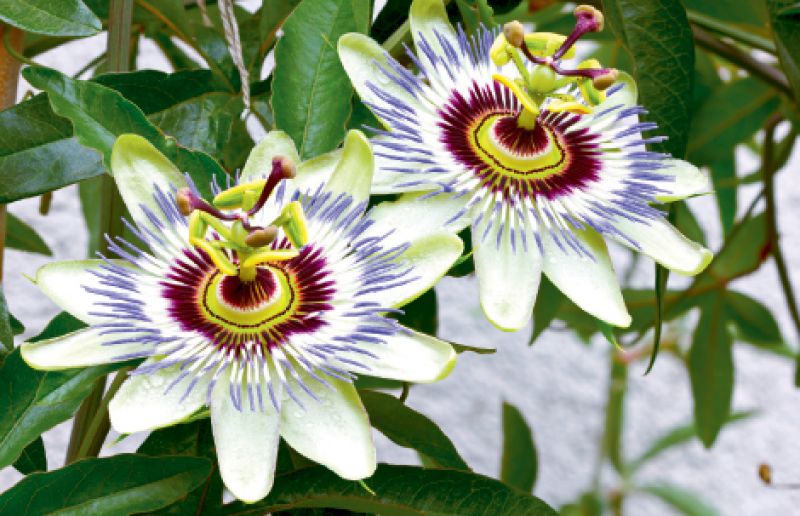
The genus Passiflora encompasses more than 400 species, nine of which are native to the United States. The spring and summer blooms of this fast-growing perennial climber can be found in many colors of the rainbow, from the cool blue of Passiflora caerulea to the scarlet petals of Passiflora miniata. While the striking hues catch your eye, it is the actual structure of the bloom that is most breathtaking, as the petals and sepals radiate in a disk- or gear-like fashion. Bring some tropical flair to your garden or favorite container with these top growers:
BLUE CROWN PASSIONFLOWER (Passiflora caerulea) above
Although not native to the U.S., this variety—with its namesake ring of blue filaments above a disk of white petals—grows well in the Southeast. It has been crossed many times to create cultivars, such as ‘White Wedding’. This beautiful hybrid has large white blooms with a light fragrance and is a great climber with strong tendrils.
Hardiness: Zones 8-11
Light: Full sun
Water: One inch of water per week, one and a half when producing fruit. Let it dry out between watering, as it does not like wet feet.
Soil: Well-draining loam
Maintenance: Prune early in the spring.

SCARLET PASSIONFLOWER (Passiflora miniata)
Trained on a plant hoop, this fiery red showstopper makes an exquisite focal point for a patio garden. A native to the tropics, it’s the most tender among this selection and best grown in well-draining potting soil in a container and over-wintered indoors.
Hardiness: Zones 10 & 11
Light: Full sun
Water: One inch of water per week, one and a half when producing fruit. Let it dry out between watering, as it does not like wet feet.
Soil: Well-draining loam
Maintenance: Prune early in the spring.

WILD PASSION VINE (Passiflora incarnata)
This native, commonly called “maypop,” can be seen growing freely in meadows or covering brambles. It produces small edible fruit and is the exclusive host plant of the Gulf fritillary butterfly (top). The mature butterfly lays its eggs on the underside of the leaves. While this vine is hardier than most varieties, winter frost will knock it back, and in spring it will reemerge.
Hardiness: Zones 5-9
Light: Full sun
Water: One inch of water per week, one and a half when producing fruit. Let it dry out between watering, as it does not like wet feet.
Soil: Well-draining loam
Maintenance: Prune early in the spring.